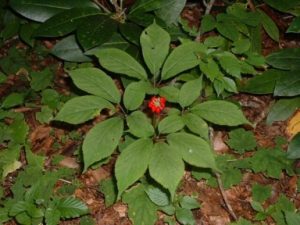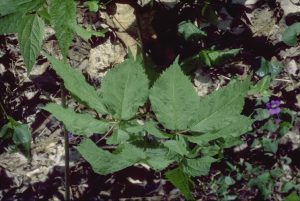
Conducted by a grant from the United States Department of Agriculture’s SARE (Sustainable Agriculture Research & Education) Program. Co-sponsored by Dr. Jeanine Davis of NCSU Extension Service. September 2002, Eagle Feather Organic Farm
The Problem
Chemical fungicides have been sprayed on ginseng for decades. The growing and harvesting of ginseng is very labor intensive. Thus, once chemical spraying was made available and shown to be effective, ginseng growers quickly adopted the use of agricultural chemicals. Therefore, the chemical spraying reduced labor costs and as a result, increased profits. The use of chemical fungicides has altered the types of ginseng available in the world market.
Traditionally, ginseng was wildcrafted (collected) from wild populations in the woods. Now almost all or the ginseng sold worldwide is cultivated. Ginseng is reputed to be the second most heavily sprayed crop worldwide, next to cotton, (but we do not eat cotton).
Major areas of production include the Orient, Canada and the USA, with Wisconsin being the major state in production. In North America there are 4 main types of ginseng: wild, wild simulated, woodsgrown and cultivated under artificial shade. Both woodsgrown and cultivated are grown in a monoculture system and are usually sprayed with at least a fungicide in the spring, (Diathane M-45 is commonly used by many growers).
Ginseng can become stressed and diseased in a mono-cultured environment. The goal of high -volume growers is to produce a marketable crop as quickly as possible. Therefore, the plants are spaced very close together and are pushed with fertilizers to speed the process. These agricultural practices however, promote the development of diseases that are able to destroy the plant and root. Thus, the grower under that agricultural system is forced to use chemicals to prevent or stop the spread of disease(s).
The mono-cultured farming approach, with the heavy use of Agri-chemicals, makes changes in the end product. In the long term, this is not a sustainable practice. In a short time, the soil can be depleted of nutrients and will be infested with diseases for years to come without intervention. Many plant species, including ginseng, may not be able to live in this polluted soil. Fungicide residues are making cultivated ginseng less desirable in the world market place. As a side effect, this heavy agricultural chemical spraying may also be affecting the drinking water in the area, along with other agricultural spraying of non-biodegradable elements.

The Site and Planting
We began with the preparation of the wooded site. On the north facing slope a ten foot high deer fence was constructed. Live trees were lashed with dead locust logs and then fencing was nailed to the dead wood. This was necessary since deer tracks had been found in the original beds.
Thirty beds in three rows were constructed. Each plot was 2.5 ft. by 3 ft. with a 3 ft by 3 ft. over-spray area between plots. All plant material was removed from the plots and a woodland soil mixture was spread over the beds.
The soil mixture consisted of 3/4 pine bark mulched COMPOST (fungal) and 1/4 worm castings, horse manure and veggie compost (bacterial). The planting occurred when the moon was in Scorpio on October 9th , a good transplanting day according to one time honored planting system. Dr. Jeanine Davis, the Project Cooperator, participated in the planting with two other people from the NCSU Agricultural Extension Service Research Station in Fletcher, NC. Nine hundred plants out of 1000 roots ordered were actually used. Each plot had thirty roots planted in five rows with six plants to a row. The spacing was approximately 6 inches between plants and 9 inches between rows.
Spraying Of Natural Fungicides
In early April the heavy leaf mulch was removed. Some plants were replanted and some were lost. A plant count was taken later in April and 674 plants had survived the winter and were sprayed with either (1) goldenseal, (2) horsetail, (3) Oxidate, (4) micronized compost tea or (5) water (as a control). This is a triple blind study and the ground was prepared with goldenseal or water drench.
Each application was scheduled to be sprayed on a weekly cycle. It should be mentioned for historical importance, that the weather was considered to be in drought conditions for the entire study.
Findings Of The Study
Dr. Jeanine Davis and her staff, headed by George Cox, prepared the final report. Initial indications were that approximately half of the spring time count survived the hot, drought-ridden summer. The control plants appeared to be the first to die off, which was anticipated. Goldenseal spray may not be as effective as the other three sprayed plots of horsetail, micronized compost tea and Oxidate.
Eagle Feather Farm uses goldenseal washes for the soil fungus, and horsetail hand sprayed on the parts of the plant that show yellowing around the edges of the leaves.